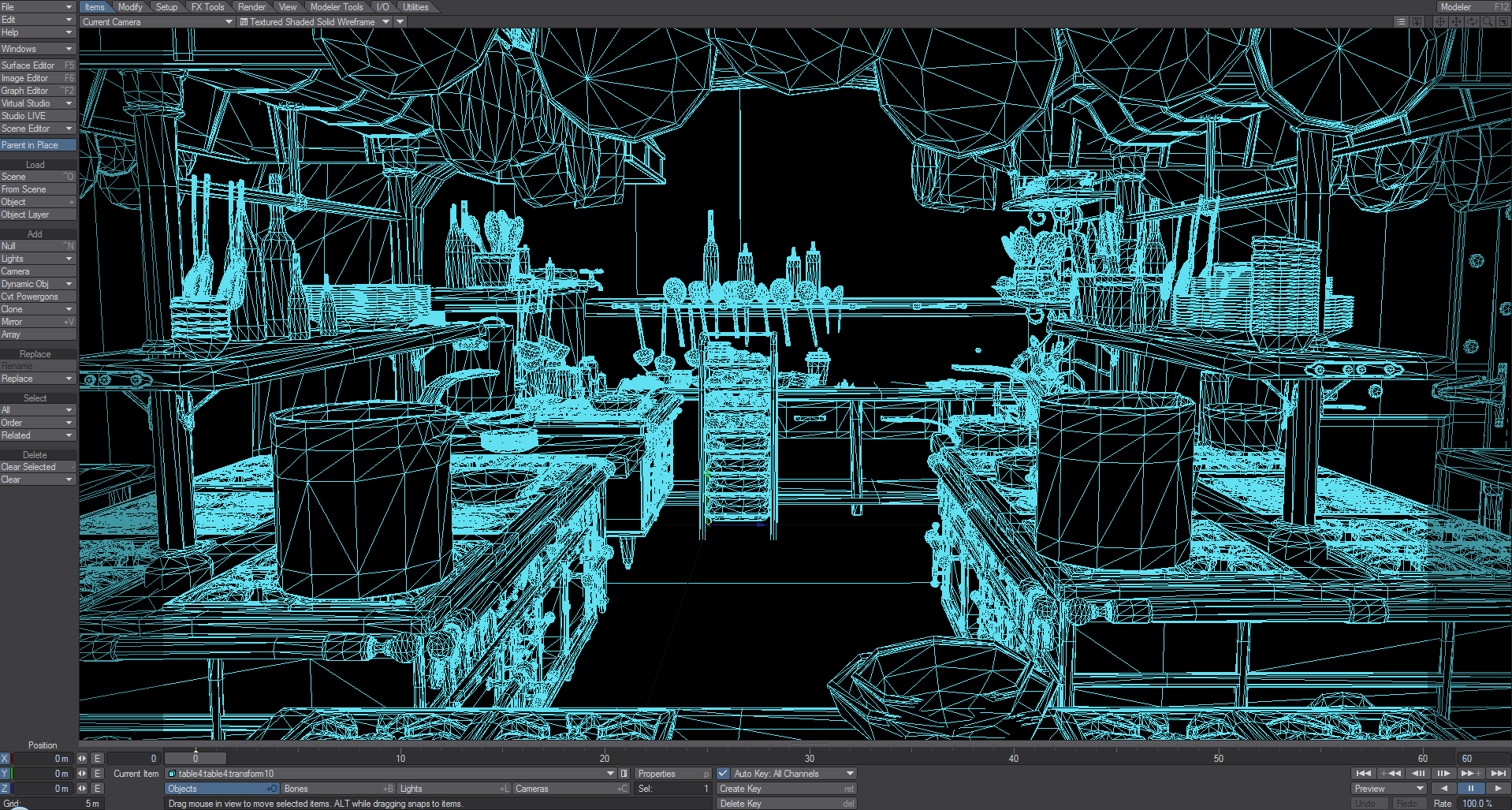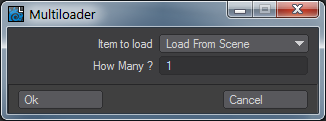Layout Load Menu
Load
Load Scene...
(default keyboard shortcut Ctrl O)
To load an existing scene: Choose File > Load > Load Scene... or use the keyboard shortcut Ctrl O and use the file dialog to navigate to the desired scene file. If the scene is not in your current content directory you will be asked if you wish to change to the new scene’s content directory, do so. While the scene is loading, a progress dialog will appear. You may abort the load operation by clicking the Abort button; however, this may result in a partially loaded scene.
Load Items From Scene
Using Load From Scene (Items > Load From Scene) allows you to import existing lighting rigs, characters from other scenes and many other things into a new one.
This can be extremely useful when working with complex scenes that have many items. Having the ability to set up a character in one scene and load the entire setup into a different scene is just one example of how useful Load From Scene can be.
Loading objects from a scene is accomplished using File > Load > Load Items From Scene.... After you choose the scene, a panel will open up and you will have the option to choose which items from the scene you would like to load. Double-clicking on the root of an item type, for example Lights, will enable/disable all items of that type. The object layer number will be listed when loading a multi-layered object.
- Expand All and Collapse All will perform the respective function on the root of the item.
- Select All selects all items and Select None deselects all items.
- Clicking on Merge only Motion Envelopes will load only the motion envelopes for the selected items.
- Selecting Load Meshes as Instances will add a null to the scene and add
In Use
There are nearly 2,000 items in this kitchen scene. If just the spoons were needed for another scene it would take a long time to pick through all 2,000, with no guarantee all the spoons would be chosen. That is why the Load from Scene panel includes a filter field at the top to allow the user to select items by filtering on a full or partial name.
Just entering part of the object name in the filter field at the top of this window will now limit the available items to load into the scene. No wildcards are necessary (* or ?) since they are implicit.
Furthermore, at the bottom of this window, you can set a pattern for renaming non-geometry items loaded from another scene to prevent confusion with items already in the scene you are loading to. Non-geometry items include Lights, Cameras and Nulls.
Regular expression support has been added to the Find/Replace fields. As with the Filter field, activate in the Find field with an @ prefix. When enabled, the Replace field may have substitutable parameters of the form <index>$ that correspond to each captured value in the regular expression (e.g., “Bob_$1_$2” would expect to match two captured text values from the expression “@^(.+)_pattern(\d+)_lino”).
Be aware that when the first child in the chain becomes the new parent of the remainder of the chain, some transformation issues may arise as that child is no longer bound by the parent’s transformations. These transformations will have to be cleaned up manually after the scene is loaded.
Load Multiple
Load Multiple enables easy loading of multiple objects or light setups. The window presents three options in a dropdown:
- Load from Scene - As with the previous Load Items from Scene, but this method allows multiples of the items chosen to be loaded
- Load Single Object - Opens a requester for loading an object. The quantity selected in the How Many? field will be loaded.
- Load Light Scene - Loads a scene with a light set up ready. It will also load nulls for controls.
Recent Scenes
Gives a dropdown with the most recently-opened scenes.
Revert Scene to Last Saved
This option will close the current scene and re-open it from the last saved version. Very handy as an ultimate undo.
Set Content Directory...
(default keyboard shortcut Alt F12)
Allows you to set a Content Directory when starting a new scene. When loading a scene a change to the scene's content directory is proposed (and should normally be agreed to).
Recent Content Directories
Shows a short list of recent content directories used. Loading a recent scene will switch automatically to the content directory used.
Load Object...
(default keyboard shortcut Num +)
When you set up a new scene, you will need to load the appropriate objects into the scene. Use Load Object (File > Load > Load Object or the shortcut +) to add objects to your scene.
To load an object file into a scene:
- If the object you wish to load is in your current content directory then it will load with any accompanying images without problem. If the object is from outside your content directory there are two main options. If the object has no accompanying images, then loading it from elsewhere won’t pose a problem anyway, but you should copy the object into your current content directory’s Objects folder. If it has accompanying images, these should go in the Images folder of the current content directory. You can perform all these steps by using Package Scene, detailed on page .
- Select File > Load > Load Object and use the file dialog to navigate to the desired object file. (Note: multiple objects may be loaded when more than one is selected in the file dialog.)
If the object contains multiple layers of geometry, each layer will be loaded as a separate editable item in Layout. An object is initially loaded so that its local Origin is at the global Origin and its local axes line up with the world axes.
Load Object Layer...
Choose File > Load > Load Object Layer to load a specific layer from a multi-layer object. A dialog will appear allowing you to define which layer to load.
Replace with Object...
Selecting an object already in the scene makes this menu item available. It will replace the object selected with one chosen from a file requester with the same keyframes already assigned the scene object. This means that you can animate a low-polygon proxy object for speed and replace it with the high-polygon final object when ready to render.
Replace with Layer...
As above, but for a single layer of an object.
Load Motion File...
Loads a motion cache file for an object. If you have baked a motion file in one of the formats supported (MDD, GeoCache, etc.) it can be loaded and applied to the currently selected object.
Import
A dropdown with Imports for:
- Alembic Loader - Loads an Alembic scene file
- FBX Import - Loads an FBX file. Can also be loaded with the standard Load Scene, or keyboard shortcut Ctrl O.
- COLLADA Import - Loads a COLLADA file. Can also be loaded with the standard Load Scene, or keyboard shortcut Ctrl O.
- MDD Multi-Loader - Loads cache files for multiple items. See the example.




